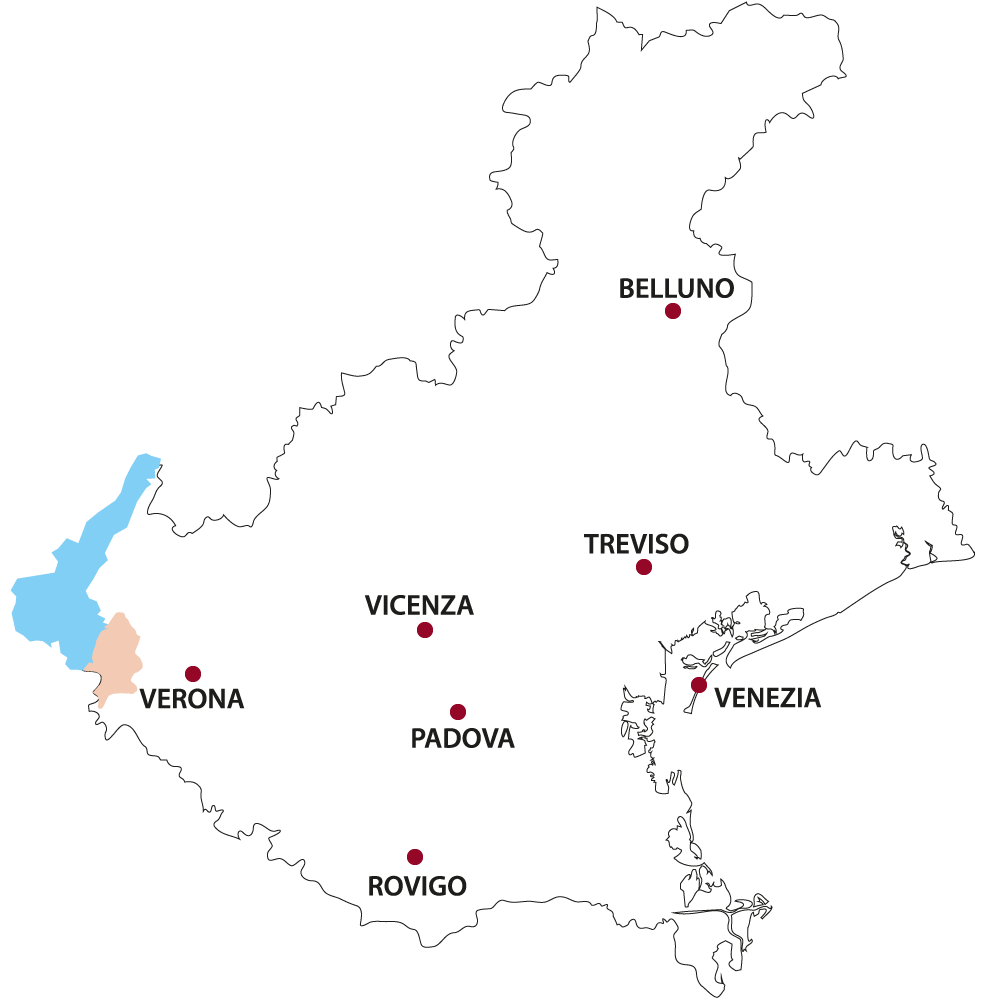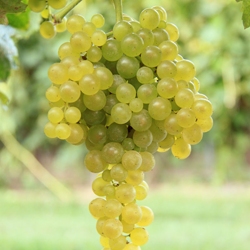

Zona di produzione
A territory rich in history and intimately related to the wine-making tradition has rightly made the Custoza famous. We are in a historic area on the morainic hills, sunny and rich with the residues of glaciers and rivers, which bring all of their mineral components to make this wine extremely pleasant in summer, fresh with friends and a must have for summer evenings. The production territory of Custoza wine includes all or part of the territory of 9 municipalities on the Veronese side of Lake Garda: Lazise, Pastrengo, Bussolengo, Castelnuovo del Garda, Sona, Sommacampagna, Valeggio sul Mincio, Peschiera del Garda, Villafranca. The soil and climate are particularly well suited to viticulture. The hilly soils are of moronic origin, and are therefore particularly rich in shells, deposited by glaciers during the quaternary. The climate is greatly tempered by the influence of Lake Garda, with a total annual precipitation of 700-800 millimetres. The territory of the D.O.C. Custoza, contained in a unique landscape between the lake and the city of Verona, and characterised by the soft roundness of the morainic hills, is sought after for its historical and artistic legacy. It is a destination for tourists that value quality of life and who are seeking a wine that expresses the identity of the territory, and which communicates the intimate ties that bind the Custoza to its land.
Caratteristiche e tipologie vino
The Custoza is produced with white vinification. Once the grapes are harvested and pressed, the must is cooled and fermentation takes place at a controlled temperature, after the grafting of selected yeasts. Following this process the wine is matured in stainless steel barrels. The Custoza Superior requires greater selection in the vineyard with a maximum yield of 120 quintals of grapes per hectare, with a production in wine of 65%, and is subjected to a maturation period of at least 5 months from the 1st November following the harvest. The Superior is an important wine that is born from the evolution of the vineyard, where there has long been a culture based on the reduction of grape yield per hectare, densification in the planting of vines, the reduction in the production of each vine, and the checking of the best and sunniest positions. This is how a wine of greater concentration and duration is born. To obtain the Spumante version, the base wine with added yeast and sugar is fermented again at 16°C for about 60 days in an autoclave (Charmat Method), where it acquires an excess pressure due to the carbon dioxide produced by the yeasts. The next step is to age the wine for 4 months in bottles. The Passito version is obtained through picking the grapes according to traditional methods. No more than 5 tonnes per hectare are destined to withering to make Passito, with a maximum yield of the grapes not exceeding 40%. The natural withering happens at rest with ventilation at the correct cold temperature. The wine must be made available for consumption not before the 1st September following the year of harvest.
Grapes
-

GARGANEGA
-

RIESLING
-

MALVASIA
-

CORTESE
Ancient vines like the Garganega and Trebbianello, together with more recent grafts for this area like the white Fernanda, Chardonnay and Manzoni Bianco, create the richness of Custoza wine vinification, which give it an accurate touch and a personality that distinguish it from all others. The Custoza is a happy combination of varieties to which the Garganega confers a delicate aroma and a pleasant flavour; the Trebbiano gives body, the Trebbianello gives pale straw-like yellow colour, pleasant fragrance, dry, full, harmonious and aromatic, the Cortese (Fernanda) provides a delicate pleasantly aromatic bouquet. The rules of production determine the apportioning of the vines: Garganega 20-40%; Trebbiano 10- 45%; Trebbianello 5-30%; Cortese up to 30%, Pinot Bianco, Chardonnay, Malvasia, Riesling and Manzoni Bianco, alone or jointly, up to 30%.
Wines
CUSTOZA
Colour: straw-like yellow
Bouquet: fruttato, profumato, leggermente aromatico;
Taste: morbido, armonico, sapido, giusto corpo;
Alcoholic Strength minimum total volume: 11,00%
Serving Temperature: Va servito ad una temperatura Di 8-10 gradi in bicchiere di media grandezza a forma di tulipano slanciato, chiuso leggermente verso l’alto per consentire un’armonica concentrazione di profumi.
Accompaniments: ottimo come aperitivo, si sposa felicemente con antipasti, primi piatti, carni bianche in genere;
CUSTOZA SUPERIORE
Colour: giallo paglierino tendente al dorato;
Bouquet: gradevole, caratteristico, lievemente aromatico;
Taste: morbido, armonico, corposo con eventuale leggera percezione di legno;
Alcoholic Strength minimum total volume: 12,5% vol.;
Serving Temperature: Va servito ad una temperatura di 8-10 gradi.
Accompaniments: ideale con pesci in genere, crostacei, primi piatti importanti;
CUSTOZA SPUMANTE
Colour: giallo paglierino più o meno intenso con eventuali riflessi dorati;
Bouquet: fragrante con sentore di fruttato, leggermente aromatico, fine e composto;
Taste: frizzante, fresco, pieno morbido, leggermente acidulo;
Alcoholic Strength minimum total volume: 11,50%
Serving Temperature: Va servito ad una temperatura di 8-10 gradi.
Accompaniments: ottimo come aperitivo, con antipasti e tutti i piatti di pesce. Può essere utilizzato a fine pasto con la frutta o con dessert non troppo dolci;
CUSTOZA PASSITO
Colour: giallo dorato;
Bouquet: intenso e fruttato;
Taste: amabile o dolce, vellutato, armonico, di corpo leggermente aromatico;
Alcoholic Strength minimum total volume: 15% vol.;
Serving Temperature: Va servito ad una temperatura di 8-10 gradi.
Accompaniments: si accompagna in particolare con dolci e formaggi stagionati;

